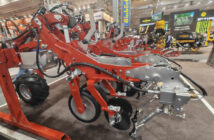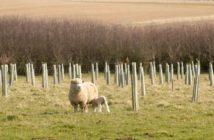There is still control to be gained from black-grass herbicides in non-resistant black-grass situations – but recent work shows that their efficacy is affected by application techniques. John Swire reports in this months issue of Agronomist and Arable Farmer
As spring approaches it is more important than ever to ensure that herbicide application is as effective as possible, says Ruth Stanley, UK technical manager for Life Scientific.
“Black-grass control is known to be application sensitive but no in-depth application work has been carried out for the Cintac and Niantic (mesosulfuron+ iodosulfuron-methyl) reference products, (Pacifica and Atlantis),” she explains.
Cintac is Life Scientific’s post-emergence herbicide for controlling grass and broad-leaved weeds in winter wheat, and iscommercially available through distribution partners ProCam and Hutchinsons.
“A key part of our approach is to support growers and agronomists to get the best performance from its products, so with this in mind we invested in trials looking at how application techniques can improve the activity of Cintac. “
Independent spray applications expert Tom Robinson trialled Cintac to understand how to get the maximum weed control by using different application methods.
Over the past two years Tom completed a number of trials at Thurlow Estates on a field scale and at a replicated site near Peterborough, using hand held and self propelled application equipment.
The trials looked at levels of black-grass control using four mainstream nozzles, the air-induction Guardian Air-05 nozzle, the traditional 110⁰ flat fan-05, the narrower 80⁰ flat fan-05; and the Defy 3D-05 angled nozzle, at three different boom heights of 40, 50 and 100cm.
“The trials found that boom height had a big influence on the amount of spray getting down to the target, with the two lower boom heights delivering the most,” says Tom.
“Even on the best sprayers it’s difficult to keep the boom at a consistent height. Bumps make booms wobble, so it’s vital to use a nozzle which operates reliably over the widest range of possible boom heights, particularly ones that produce a consistent spray pattern at the lower range.”
So what does this mean in practice? Quite simply, if there isn’t good control of the boom when it’s running at 50cm, then you won’t get the performance Cintac is capable of, he explains.
Tom also looked at the effect of boom height on spray pattern for each of the four nozzles using a Hypro patternator, using the internationally recognised Julius Kühn Institute (JKI) standard to appraise each nozzle’s consistency in performance at different boom heights.
This test really sorted out the differences in the nozzles, he explains. “The results showed that the Guardian Air and Defy 3D nozzles were the only two nozzles that met the JKI standard at all the heights tested – 40-100cm.”
The trial was repeated in Feb 2019 using Cintac applied at 0.5kg/ha plus 1.0l/ha (adjuvant) in 200l/ha water through all four nozzle types at a forward speed of 12km/h and a boom height of 50cm.
“The second trial gave slightly different coverage results but again the Defy 3D gave the most consistent coverage.”
Financial benefits of improved spray application
Blackgrass head counts were made in May and showed that all the treatments had provided effective levels of control compared with the untreated control.
“Using yield loss and head count data from Dr Stephen Moss we were able to predict yield loss and determine the financial cost of using the different nozzle types to apply Cintac,” explains Tom.
“While all the treatments had a commercial benefit when predicted yield figures were analysed, using the Defy 3D nozzle gave the highest predicted yield benefit of 1.3t/ha over the control, worth an extra £175.50/ha (with wheat at £135/t).”
“The 110⁰ flat fan nozzle was marginally lower, giving a yield benefit of 1.2t/ha over the control (worth £162).”
“The 80⁰ flat fan was predicted to give a yield benefit of 1.0t/ha (worth £135) and the Guardian Air was predicted to yield worst of all, producing an extra 0.5t/ha (worth £67.50).”
Getting the best from Cintac application
Water Volume 200 l/ha
Nozzle Height: Maximum 50cm above crop
Forward Speed: 12 km/h (maximum)
Nozzle Type: Defy 3D
110o fan jet also recommended




